Six years ago, Portland-based engineer Chris Hoffmann was driving with his 13-year-old daughter Lauren to go fishing. On the journey, out of the silence, Lauren said, "Daddy, I've been thinking about this one-wheeled motorcycle I saw in a video game. Could you actually build something like that?" What happened next changed his life.
In the next few months, Chris begins shipping the first production version of the Ryno, a self-balancing, one-wheeled US$5250 personal mobility device that has caused tidal waves of interest across the internet with global distribution and manufacturing on several continents in planning. This is Chris Hoffmann's story of what happened in the intervening six years, in his own words.

Chris takes up the story: "I said to her, 'what does it look like?' While we were riding along, she got out a piece of paper and sketched it and that's where it all started. She showed me the sketch and we started talking about it and she knows I'm an engineer and we talked it through while we were driving."
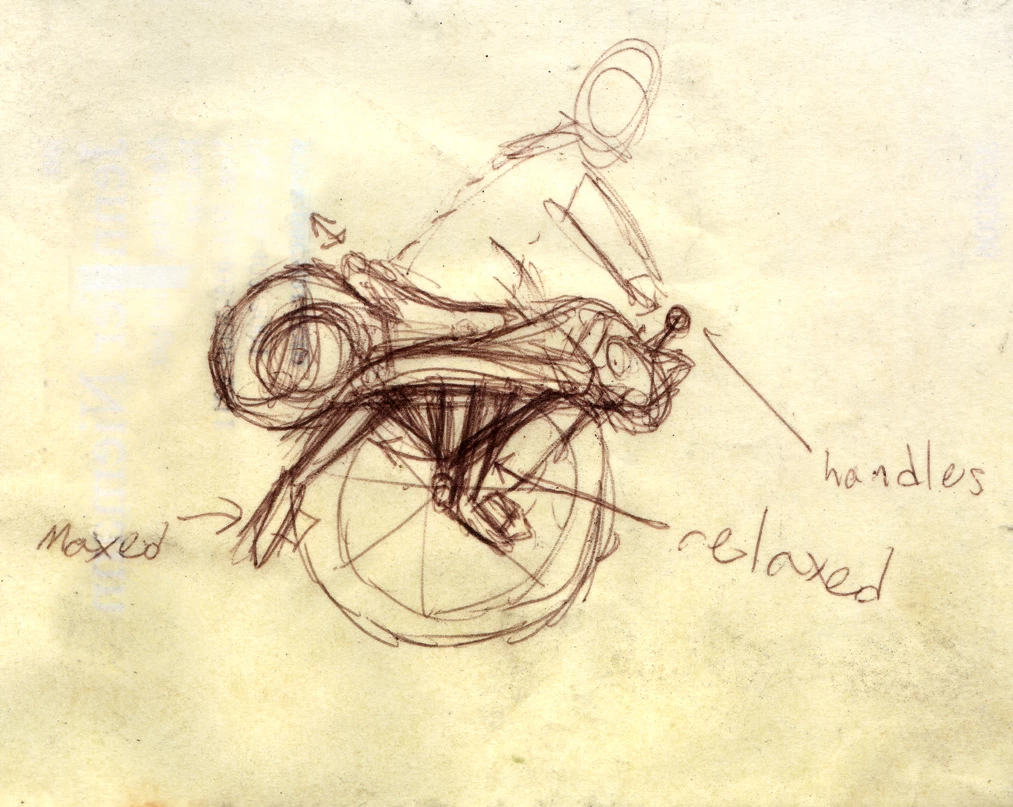
"I said, 'you know, there's self-balancing technology that is used on the Segway that could work on something like that, and if we took a big motorcycle tire and … hmmmm … it's definitely not impossible.'
"So I started thinking about it and it got me intrigued.
"When I got home I got on the internet and started looking for that one part that's missing and is going to stop you from doing what you want to do, and I couldn't find it. I just kept finding what I wanted. It was around 2008 when gyro technology started getting really cheap. All those little radio-controlled helicopters have gyros in them now and the sensors you need for that technology are also cheap and actually predate the iPhone because it has one inside. Back at the time the Segway came out, that type of technology cost you $500 and now it's more like $10, so that didn't stop me."

"I looked for motor controllers and servo motors and things like that and … you know it's funny that this Battlebots TV show and all these competitive robot competitions have created a whole cottage industry of geeks making controllers and boards and motors for these robots and they were all the perfect size for this little transportation device I was scoping. So I was able to search on the internet and I was able to go, 'here's a little motor controller for $150' and 'here's another bit I need' and … pretty soon I was doing some sketches to figure out how to package all the bits together."

"It's amazing what you can do on the internet these days – what you can pull together just sitting in front of your computer. I quite literally found my software-hardware guy on the internet because he had posted a web site about how to make a wooden Segway as a kit project. Most other things I needed I found there too.
"Then I took a machine shop class and using the skills I acquired, I built the first prototype. I'd spent 15 years in the auto industry designing big heavy plant-sized machinery, so I'm a pretty good mechanical engineer and I spent five years in consumer product development doing circuit boards and electronics and communications gear, so I know how to talk to those guys.
"The very first prototype was just an exploration. I took my mountain bike and cut the frame in half and took the seat off and put the handlebars where the seat was and then put some foam on the parcel shelf on the back and tried to see if I could ride it around. I did that just to get my head around how you would ride on one wheel and that was … well … impossible.

"So it was important to get the gyro stabilization sorted out … I didn't want to make three prototypes, I just want to make one that worked and looked great, … so I built this beautiful hammered aluminum, aircraft-looking prototype and figured it would just steer around a turn like a coin rolling around a corner, but when I got on the thing, it was … impossible."

"I mean you could hardly get it to go in a straight line because it was just an anvil on one wheel. It would balance front-to-back, but there was just no way to impart a twist on the thing.
"So my software guy and I got together and said, 'now what?' We were thinking about all types of crazy ideas such as flywheels spinning and two tires side-by-side and he was looking at me going, 'dude, it's a controls nightmare. It's going to be too expensive to build and it's going to be too complicated – it's gotta be dirt simple.'
"Well, in the end, the thing I figured we could do was just add steering. He was like, 'well that doesn't make sense – it's only one wheel – how does that work'?

"In the end, we built a frame and just added handlebars. He loaded the software and we took it over to my house and I got on it and I just rode off, just like a bike. I was riding around the neighborhood inside 15 minutes. I was riding around doing figure eights. It just totally blew me away because it worked really well.
"We had both got to that place of 'maybe this is gonna work and if it doesn't work, we're done, we gotta go get jobs.'
"But it did work, so we took it back to the shop and welded some body panels on it and bondo'd it and painted it and filed some patents and shot some videos and put them on the internet and it got picked up and we started watching the number of views grind away and before long we got to the point where we realized that people really liked this thing and that it was viable.
"It wasn't until we took it downtown and started riding it around that we realized just quite what a utilitarian product it is. When you ride it onto the train and no-one says anything, and you go in an elevator with it and no-one is backing away from it and people start asking you about it and when you go on the street and people start pulling their phones out and begin taking pictures of it, you realize that this thing had something going for it.
"Then we built another prototype. We figured we could take it another step. We said, 'what's this thing really gotta be'?
"We figured that we would make it street legal like a scooter, 25 mph less, 750 watts of motor power, add suspension, a bigger seat, euro styling … so I actually sold my house and got some cash together and we spent about $45 grand on this one prototype and … it was a total failure.

"It failed on so many levels. 750 watts is not enough power for this thing to do what it needs to do and we had added suspension to it which had sort of decoupled the handlebars from the gyros inside the wheel.
"There's a very subtle way you pilot one of these … by pushing the handlebars down to go faster or pulling pack to slow down … and having the suspension was like you were pushing against a marshmallow. I'd never thought about that on the drawing board but I got on it and tried to ride it, it was like … OMG, this totally fake.
"When you're a start-up, there's just not a budget for doing a lot of engineering prototypes. You can't just take half a dozen fabricators and knock some stuff together and test it and go back and do it again and again. You don't have the money for a test stand or a dyno … you just have to take your best shot.
"What was funny about that prototype though, was that we put some pictures up on the internet and we started getting a lot of emails of people that wanted to buy it because it looked so cool.
"I think we got five people who were prepared to give us US$25,000 apiece for these things … and here I was struggling to get it to even work properly.

"It was right at this point where I met my operations guy Tony Humpage, he's my right hand man. He has an MBA, and he's an old school British guy who has done a lot of start-ups and he looked at me and said "dude, if you build those five bikes, you're gonna get stuck in a garage building one-wheel bikes for the rest of your life, so stop doing that and let's get together and write a business plan and let's see if we can get this thing to scale.'
"And that's when we started working together and we wrote that plan and raised the first US$1.3 million.
"He pushed me out of that classic inventors dilemma. Inventors always feel frustrated and they want to make progress so they go back to the garage and just keep polishing up the same thing, thinking they're adding value when it's not always the right thing to do. There are times when you need to stop doing that and do something that's a little outside your comfort zone.
"For me, that was the beginning of a completely different journey in becoming the CEO and manager of a company."
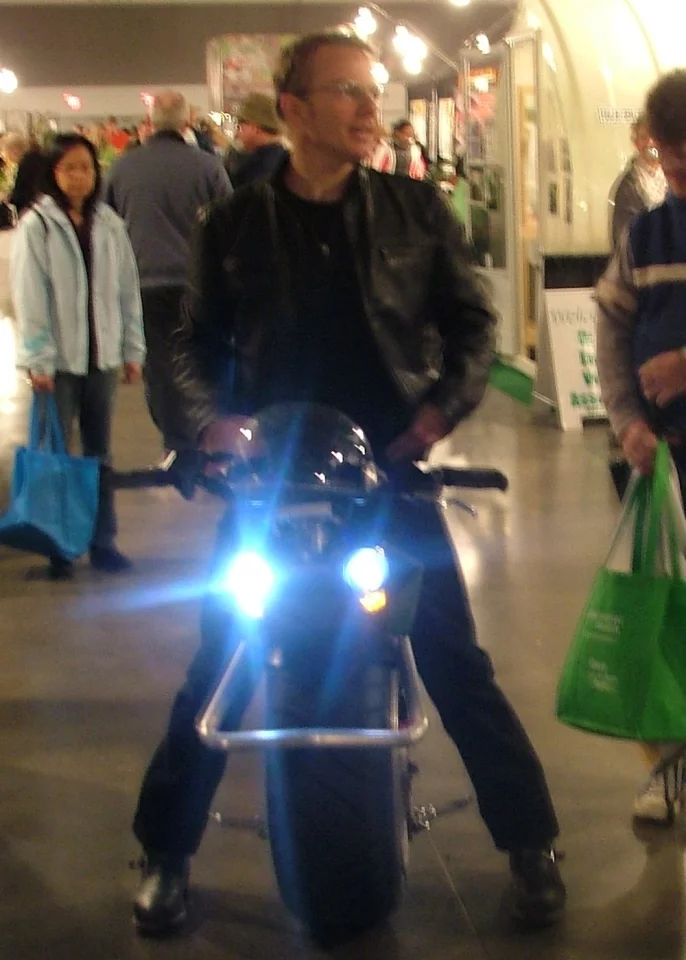
Gizmag: What's next in the evolution of the Ryno?
"Obviously we will develop the next version of the Ryno. It's obvious what we need to do. It will be better if we make it lighter, a bit smaller, extend the range, but I think the sweet spot is still in that 10 mph range because it's a low-speed, meandering-around-town mobility solution that mixes with pedestrians and let's you hang out with other people without scaring them and making them back up.
"If you want to drive down the road at 25 mph or faster, then go buy a Vespa scooter."
Gizmag: I noticed that you are not using lithium ion batteries in the standard US$5250 Ryno, and that you can have lithium Ion batteries if you're prepared to pay extra. Obviously, that additional cost is considerable right now, but is there a time when you foresee it being part of the standard offering?
"We're tracking battery technology very carefully right now along with everybody else, and the lithium ion battery manufacturing process is getting really refined and it's going through a transition right now into a more mature technology – it's a bit like the hard drive industry was a few years back where the material science all of a sudden gets really good and the cost starts to fall quickly.
"Lithium ion batteries have always been made by a couple of big companies that have managed to get the chemistry right and they have to get the separator materials perfected and they do it in-house. Now, we're seeing mid-level suppliers emerging that sell rolls of separator material and they're selling the good chemistry and they're selling the packaging so there's all these companies now that are able to layer up this little lithium ion sandwich and seal it up in a little tin-foil bag that looks like a pop-tart, and they're getting really good at it, so the price is starting to come down.
"So adding lithium ion batteries to the Ryno will probably come down to around US$1000 in the next year, which will make everything a quantum leap more viable again for really useful, viable personal mobility appliances. It's an exciting time, because the technology is finally maturing."
Gizmag: The tire is a motorcycle tire. How did that come about?
"The iconic thing about a Ryno is that everything is inside the wheel and then you have this tubular steel frame that sits up on top and it kinds of looks like magic, because people look at it and say 'hey, where's the motor?'
"So to fit all that stuff inside the wheel we needed a big wheel and it's not so much that we wanted the bike to have a big wheel so it looked bad-ass, it's just that the wheel is the body, so we looked around to find the right tire and we came up with an off-the-shelf, 18 x 240 sports motorcycle tire and rim.
"So instead of having spokes on the rim, we built a wheel center just like the spare tire on a car, and we mounted it way over on the side, so we have a conventional motorcycle rim and there's an offset, stamped steel wheel center that allows us to mount all the machinery and electronics and batteries and the wheel sits around the outside."
Gizmag: Will Ryno develop other products?
"Ahhhh … (reluctantly) … I can probably talk about it, mainly because I don't think anyone else is going to do it, but I wouldn't mind doing a self-balancing hydrofoil jet ski. Hydrofoils are very efficient, they take out all the friction, so much great speed on water is possible. Just look at what they've done for Americas Cup sailing speeds."

"A self-balancing hydrofoil jet ski like one of those hydrofoil wakeboards, but without the ski boat, now that will be really bad-ass for a whole new bunch of people. That's one of the things I've been looking at doing."
Gizmag: What makes the Ryno different as a Personal Mobility Product?
"As cities get more crowded and people are forced to get closer and crowd together in big cities, there's something about the Ryno's ability to spin around on its axis, and that most of the machinery is hidden and silent, that makes it non-threatening. The rider-to-pedestrian interface is a leg-to-leg interface, an eye-to-eye interface, a person-to-person interface. Unlike a car or a motorcycle or a pushbike, there's no barrier, so the Ryno feels approachable … and the fact when I stop I put my feet on the ground and the vehicle feels and looks very stable, so people don't feel like they need to back up and get away from it, like it's going to run their toes over.
"It's funny how the non-threatening nature of the Ryno has such an impact when you roll up to a group of people. It's more like you're hanging out with them … everyone feels like they are at the same level. It's eye-to-eye, like the rider is accepted as a peer, like we're together, as opposed to other vehicles where either you're eight inches higher than pedestrians and need to get down and step off to one side, or a bicycle where you're sitting on this thing and if everybody needs to move a little to the right, you need to get off and wheel it around and … it's not the same.

"The Ryno is different because it can move and pivot freely, like a human can, so the rider can mingle with footpath users, just meander and flow with the movement of the people. I think that ability to mix with people is the Ryno's biggest attribute – it's ability to move gently in slow motion in a crowd, its non-threatening movement in a crowd, it's ability to appear as stable as a human and just hang out in the crowd, to move 50 feet up the pavement and stop and put your feet down and look in the window.
"It's not like a Vespa scooter where you get on it and just commute – that's what a scooter does. It goes on the road an it commutes, like a car. The Ryno is different. It's not necessarily going to get people out of their car, but if you can picture how you transition from one form of transportation to another, if you think about pedestrian traffic, where people are on foot, and as pedestrians they are on foot, and can only really comfortably go about ten blocks before they get tired, that's the Ryno's environment.
"There's this unconscious notion we all have that we have to get into a car to go farther than five blocks. Well, the Ryno is going to push those boundaries outwards … a lot. It's a mobility aid for people who aren't mobility impaired. Instead of meandering five blocks, you can meander five or ten miles and back and you won't get tired … and you can do it at the same pace as a professional athlete, and you still won't get tired.
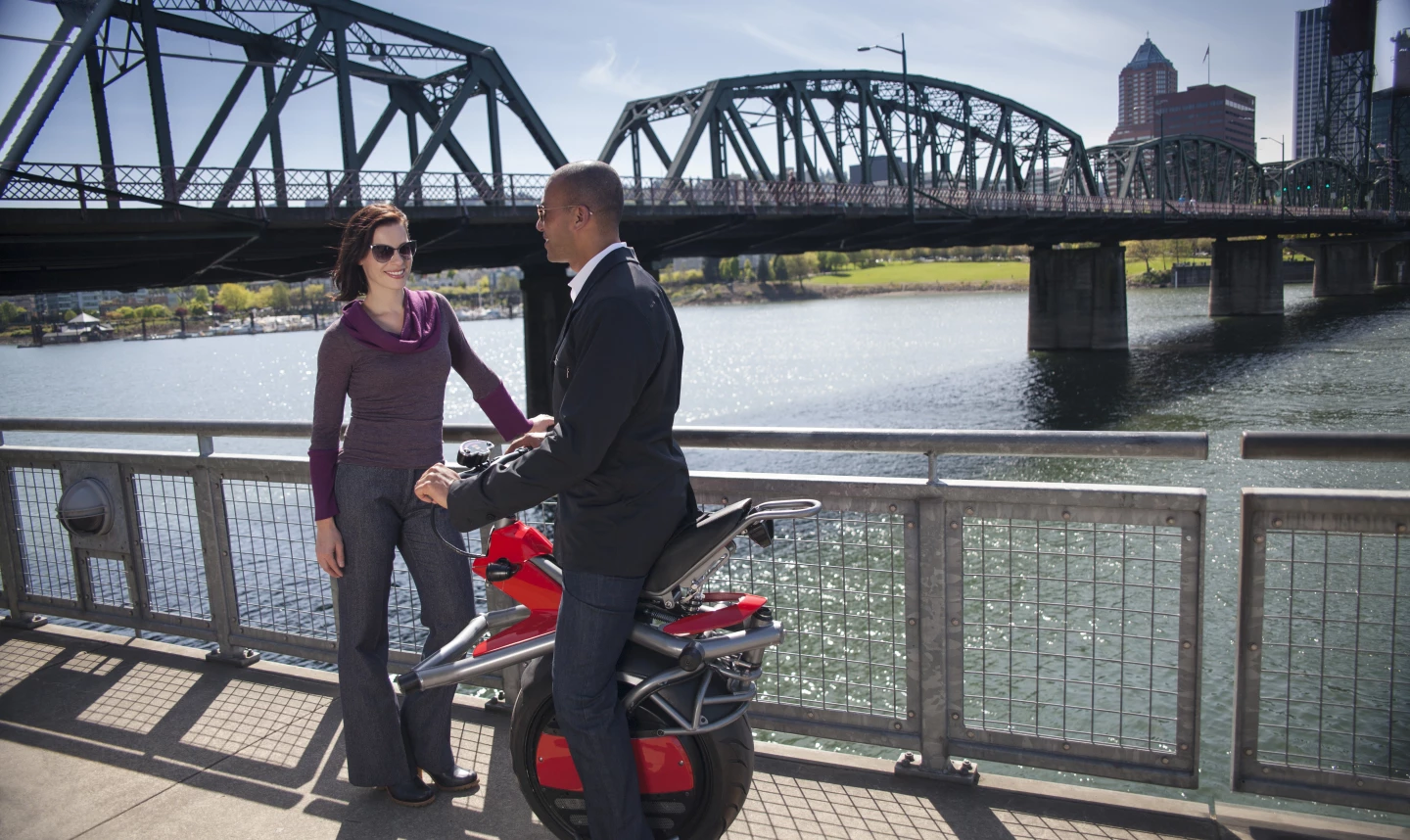
"I think things are going to change a lot due to the advent of these new personal micro transportation devices. Now they're available and affordable and viable, we can now put the cars on the periphery of a much larger area and allow people to just wander around without having to mingle with big metal objects that weigh a ton potentially running over someone and hurting them – these devices will enable people to wander around in an assisted way – in a way that allows them to cover more ground.
"So whether it's the Ryno or whether it's some sort of small one- or two- or three-wheeled device, I think as people can mentally start to think about this middle ground of personal mobility, then new things are possible. We now have technologies available to us, so we can rearrange what we have to make it more liveable, more pleasant ... much safer. This new way makes more sense.
"If you start thinking about how that level of personal mobility, with its very small footprint that's not much bigger than a human being, can get onto a train, and the train can transport it to the general area of where they want to be, then they use the mobility device to complete the journey, then you see a very different transport ecosystem, one for which the transport infrastructure is largely in place already.
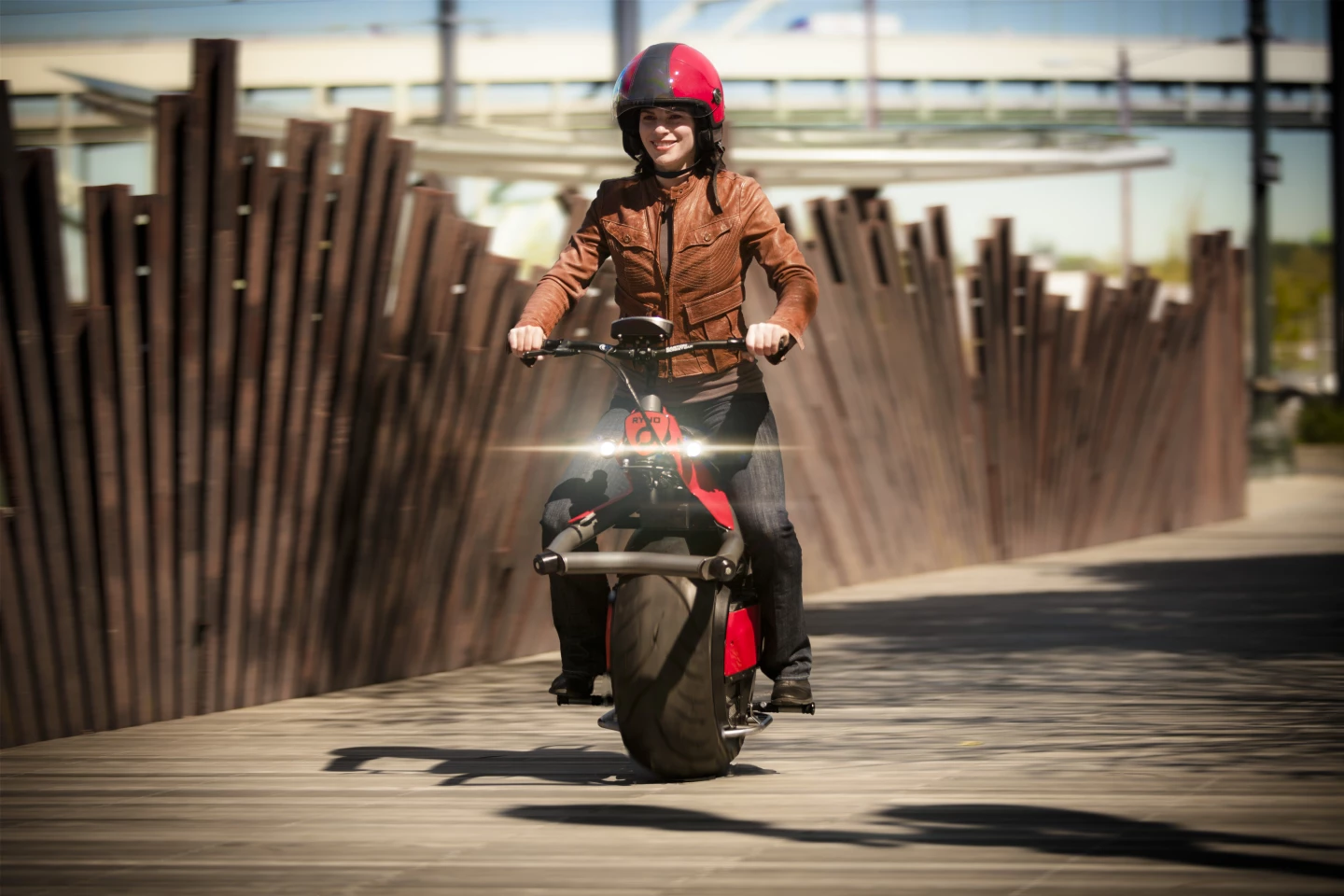
"Trains could begin with a compartment or car allocated to personal mobility products, and if more people start to use them, then more cars on the train could be allocated over time. I'm not talking about a bike rack in the front of the train, I'm talking eventually a whole train where the door opens up and everybody with their little mobility products get on and off, and everyone can go from one point in a city to another, or even from city to city. The train takes them from inside one personal mobility circle to another personal mobility circle.
"When you do that, things start to change. We don't need to have a city street wide enough for a massive truck to reach every front door in a city.
"To me, this concept looks viable. I would challenge people – academics, city planners, students, to do a study, a computer simulation, an impact assessment and take that concept to the next level because I really think that is where we need to go in the future.
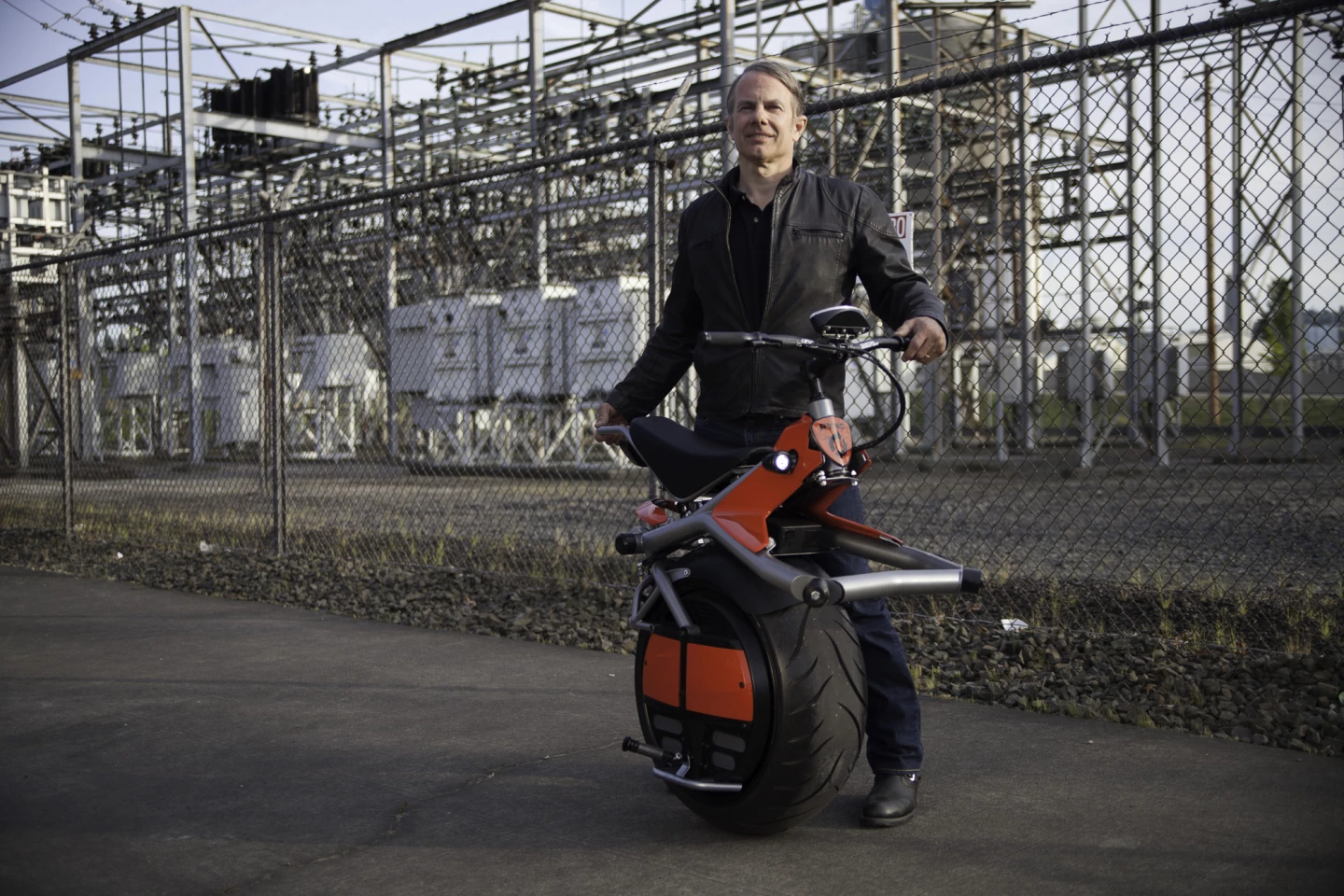
Gizmag: So what have learned about business and the entrepreneurial process that you can pass on to your fellow entrepreneurs and inventors?
"Wherever the idea comes from, whether it's pure inspiration, or trying to solve a problem or wherever, you must take that idea into the marketplace and show it to people and see if it shows up the way you think it does. If you're a band, you have to go play the subway at some time and see if people put money in the hat. That's the first step. That prototype, that proves that the thing exists and embodies the features and benefits that you think it does, is all you need to do.
"You build a prototype that captures the essence of what you have in a way that you can scale it. You've solved all of the technical challenges, maybe the software isn't perfect but you know the software issues can be solved, and you have all the major components and you don't have to invent something that doesn't exist and you know that you have a system that fundamentally works and stop at that point, because investors, they understand the rest of it.
"I was surprised at first because I'd go into a presentation and I would start talking about the product and how awesome it is and all the technical part and they'd say, 'we don't care about that, we get it, we get the one-wheeled thing and you're an engineer and we believe you can build it, now tell us how we're going to make money?'

"To go to the next level, you have to switch into a completely different mindset … or find other people who can play that role … and you have to build a plan with real sales numbers and real dealer channel information and show how your idea will actually make money.
"Another thing is that when you go in to talk to investors, don't go there trying to sound like you know all the answers. The more you sound like you are flexible and open to discovering what's going to happen and that there's enough money in the budget if things aren't going to plan that you can and will pivot and do it differently, investors actually like that.
"Investors like the fact that you're trainable, that you're aware, that your ego is not tied to your ideas, that you know you're managing a business, and that you have a process. Investors are more interested in that you are aware there is a process to get there, as opposed to always knowing what the right answer is.
"It's been a really interesting journey of being open and transparent and saying, 'I'm not perfect and I don't have all the right answers straight up, but I have developed a process and a timeline and a budget on how to get there and that's what I'm selling. I'm selling an opportunity, I'm selling a journey.'
"I'm selling finding out the answer to this question and if the answer is yes, then we all make a pot of money and if the answer is no, then we fall into the nine out of ten companies that fail. It's up to you to decide if this company is worth investing in, and my job is to reduce the risk that you're trying to come to grips with.
Gizmag: What advice would you give to inventors out there?
"A, you're building stuff but B, when you've built your first prototype, put it in front of people who know, and if they think it can fly, you need to turn into a businessman pretty quick.
"Another bit of advice I'd give to inventors is that when an inventor embarks on a journey, there's a certain amount of letting go. You almost have to be ready to let go, to be ready to give yourself to the process and the process is not so much willing and forcing something to happen, it's about reducing the obstacles for something to show up, for good things to happen.
"So my job as a company leader is how to reduce the chances of failure or reduce the chances that something bad can happen, because I can't always control the good things that are going to happen quite as much. It's becoming emotionally unattached.
"If you get too emotionally attached to what's going to happen tomorrow you'll give yourself an ulcer or a heart attack. So for me, it's 'how am I going to show up today?' and 'am I going to do the best job I can and stick to the plan?' You must always have a plan in play. I don't necessarily know where the road is going but I need to stick between the guardrails.
"If you have a destination, it doesn't matter so much how far your headlights reach into the future, just don't rub against the guard rails for too long. You have to stay as close to the middle of the road as you can so you can feel the momentum growing, and the growth and journey progressing. If it's not fun any more, it's because you don't see it as a journey, and how you're going to evolve as a person, and effectively learn the lessons that present themselves, and the lessons that you're going to help the people around you learn. Why are the people around you there? What's their motivation? Why are we all working so hard on this?"
Gizmag: Where does the journey lead from here?
"We're within a few months of shipping the bike which we showed to the market, the one that's on our web site and in the videos and what the public has seen, so that's pretty exciting. In the space of one year, we've taken the lessons learned from three prototypes and baked them into a product that's pretty bad-ass.
"What we're now doing is being very strategic and careful about how we scale the business, how we roll it out, the level of noise we're creating that we need to support with the resources we have and developing a global strategy on how we would duplicate manufacturing in different geographical areas around the world and how we'll have different types of distribution in different countries and how it will be supported.

"We are getting a lot of interest from around the world from different companies that want to license and manufacture the Ryno – from places like India and Brazil, or companies that want to distribute the product. It really has been an amazing reaction globally. So we're looking at all the different ways we can service different countries and allow people to adopt this new and quite unique form of urban transport. If companies are interested in becoming part of the ecosystem we're building, they should contact us soon, while the strategies are being decided.
"We're orchestrating a staged global roll out and distributed production is the strategy, without manufacturing and distributing it all from one place in Portland, Oregon. So we're being very careful, taking our time to ensure the brand is really clean. It's more of a bigger chess game right now, rather than making a lot of money as fast as we can selling product in the short term, we're continually adding long term value to the company by moving slowly but strategically instead.'
Gizmag: Why are you doing this?
"I've been with my software guy, Tony O, for quite a few years now and one night we were sitting there really frustrated with a problem and I turned to him and said, 'why the hell are we doing this?' and he stopped and disconnected from the problem for a moment, thought about it, and said, 'because no-one else is doing this, and if we can make this thing do what we think it's gonna do, that's pretty awesome, and I'd much rather be doing this than working as a lab rat in some company.'
"He said, 'Man, I'm in the game.'
"That's what entrepreneurialism is about. Stay in the game, get your people in the game, don't run out of money … just stay in the game."
Product page: Ryno Motors
































